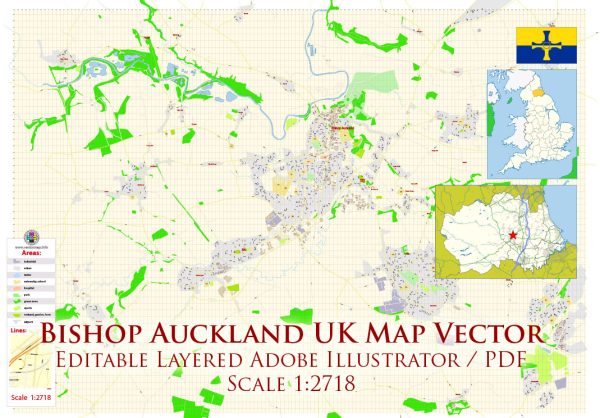Bishop Auckland is a historic market town located in County Durham, England. Its history of urban development can be traced back over a thousand years, and it has evolved significantly over time. Here is a brief overview of the history of urban development in Bishop Auckland:
- Early History: The area around Bishop Auckland has been inhabited since Roman times, and it was part of the Kingdom of Northumbria in the early medieval period. The town’s name is derived from its association with the Bishop of Durham, who owned extensive lands in the area.
- Norman Era: In the 11th century, Bishop Auckland was granted to the Bishops of Durham by William the Conqueror. The Bishops built Auckland Castle, a significant and enduring architectural landmark, which served as their primary residence. The castle and its surrounding estate played a central role in the town’s development.
- Market Town: By the Middle Ages, Bishop Auckland had become a market town, where local residents and traders gathered to exchange goods and services. The town’s market charter was granted in the 12th century, further solidifying its role in regional trade.
- Industrial Revolution: In the 18th and 19th centuries, the town experienced growth and development due to the Industrial Revolution. Coal mining, quarrying, and brickmaking became important industries in the area. This led to an expansion of the town and an increase in population.
- Railways: The arrival of the railways in the 19th century had a significant impact on Bishop Auckland’s urban development. The town became a major rail hub, facilitating the transportation of coal and other goods to other parts of the country.
- Housing and Infrastructure: As the town grew, there was a need for improved housing and infrastructure. New streets, houses, and public buildings were constructed to accommodate the increasing population and to support the local economy.
- Decline of Traditional Industries: The 20th century brought significant changes to Bishop Auckland as traditional industries like coal mining declined. This led to economic challenges for the town, but efforts were made to diversify the local economy and redevelop former industrial areas.
- Modern Redevelopment: In recent years, there have been various efforts to revitalize and redevelop Bishop Auckland. Auckland Castle, which had been in private hands for centuries, was reopened to the public as part of a major restoration project. The town has also seen improvements in infrastructure, tourism, and cultural offerings.
- Current Status: Today, Bishop Auckland remains a thriving market town with a mix of historical and modern elements. It is known for its historic sites, including Auckland Castle and the medieval Market Place, as well as its connection to the Bishop of Durham. The town’s economy has diversified, and it continues to evolve as it balances its rich heritage with contemporary development.
Bishop Auckland’s history of urban development reflects the broader historical and economic trends of the region, and its ongoing efforts to preserve its heritage while adapting to the changing times.


 Author: Kirill Shrayber, Ph.D.
Author: Kirill Shrayber, Ph.D.